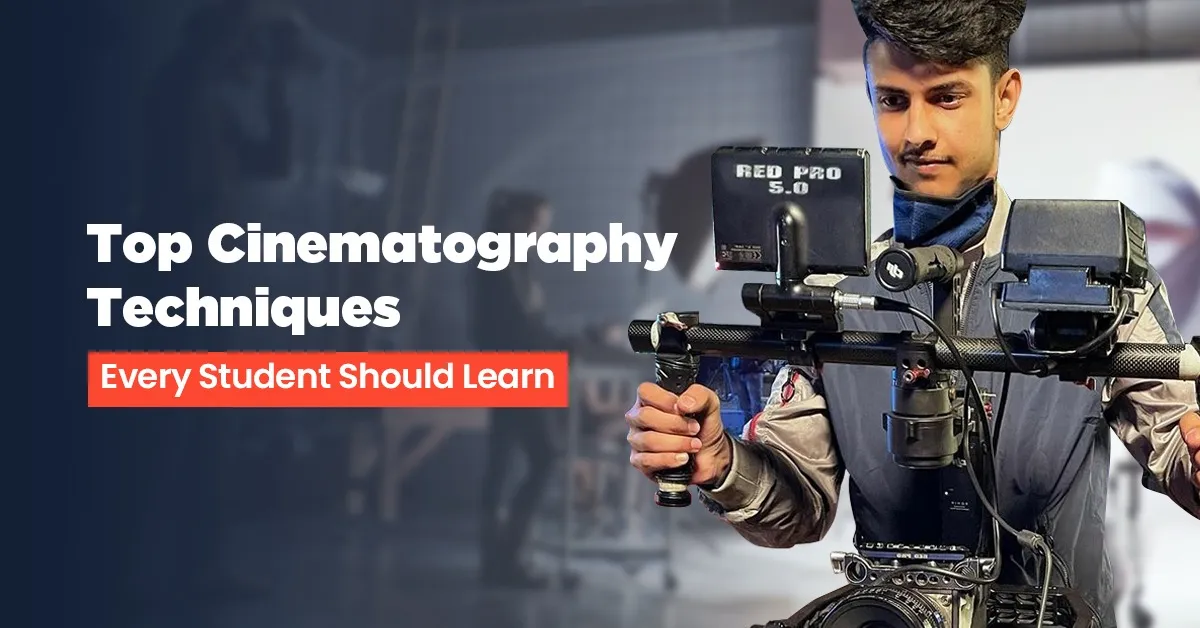


30, August 2024
Telling a story through a camera can be called cinematography. It is an important part in the development of a film. Learning the key techniques of cinematography enhances the ways of telling your story. Here are some of the top cinematography techniques every aspiring cinematographer student should learn about.
Composition decides how visual elements in a frame are arranged to convey the desired emotion to the audience. It is the foundation of cinematography. Rule of third is one of most important principles; it states that the frame of the camera should be divided into 9 equal parts. The rule further states that the important parts of a scene should be placed on these lines or where they intersect so that they attract the eyes of the viewers. Sometimes cinematographers break this rule to make unique and original shots. To master composition, aspiring cinematographers should learn about different compositional techniques like symmetry and framing.
A cinematographer should lnow about the practical applications of lighting when shooting a scene. Lighting easily enhances the story. Different genres of films require use of different lighting setups. Aspiring cinematographers should shoot scenes with different kinds of lighting setups to know about the differences between each kind of lighting and their uses.
How a scene is shot sets its mood. Fortunately, there a various types of shots that provide cinematographers a chance to unleash their creativity. A good cinematographer knows which shot to use and how. To change the perception of a character, camera angles are used. By learning how to use a camera, aspiring cinematographers can control the emotional impact of their films.
It refers to the distance within a shot where the subject is in acceptable sharp focus. It is used to direct the audience’s attention to a particular subject. When the subject is focus and the rest of background is blurred isolating the subject, it is called Shallow depth of field. This technique is used mainly to draw attention to an important part of the scene. Deep depth of the field is mainly used in wide shots to show the whole scene. In order to learn about depth of field, aspiring cinematographers should understand how aperture, focal length and camera affect each other.
Colour grading is important part of cinematography. Correct use of colours can set the right atmosphere and enhance the story. Cinematographers use different colours to subtly influence the emotions of the audience. Colours like red provide a sense of warmth whereas colours like green provide a sense of calmness. Aspiring cinematographers should learn the effects each colour has on the audience.
A storyboard is created before the start of shooting. Storyboarding is where the sequence of events is planned, with what camera angles, movement and lighting to use for them. This helps in making sure that each shot has a purpose. Shot planning involves understanding the pace of scenes and how they are going to be edited. By mastering storyboarding and shot planning, aspiring cinematographers can ensure that not only their work looks good but they can easily communicate to the audience.
Choosing a wrong lens can ruin a shot. Aspiring cinematographers must have know about each lens and their use. For example, for landscape shots or scenes that require a large field of view, wide angle lens are used. Telephoto lens can make characters appear closer than they are whereas standard lens have a superior image quality. A good cinematographer should know the difference between the usage of each lens.
For a cinematographer, learning how to work outside under the sun, and use tools like reflectors and diffusers to manipulate natural light is important. The midday sun creates unwanted shadows and contrast. Practicing shooting in various natural conditions should help aspiring cinematographers understand how to harness natural light.
Cinematographers also take part in the post-production process. They work with the editors closely to make sure that the final footage enhances the story even more. Learning the basics of helps cinematographers work easily with video editors and make wise decisions.
Learning cinematography requires a deep knowledge of the technical aspects of filmmaking. By mastering the above mentioned techniques, aspiring cinematographers and enhance their way of telling stories. However, as with every other art form, practice and experimentation is the key to success.